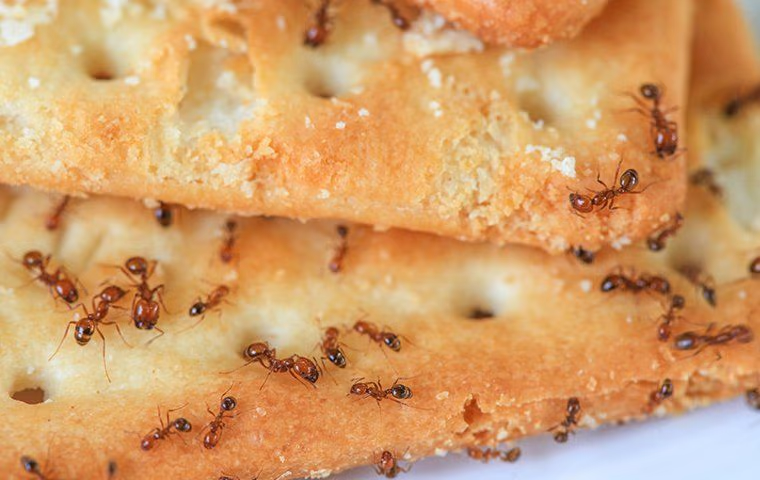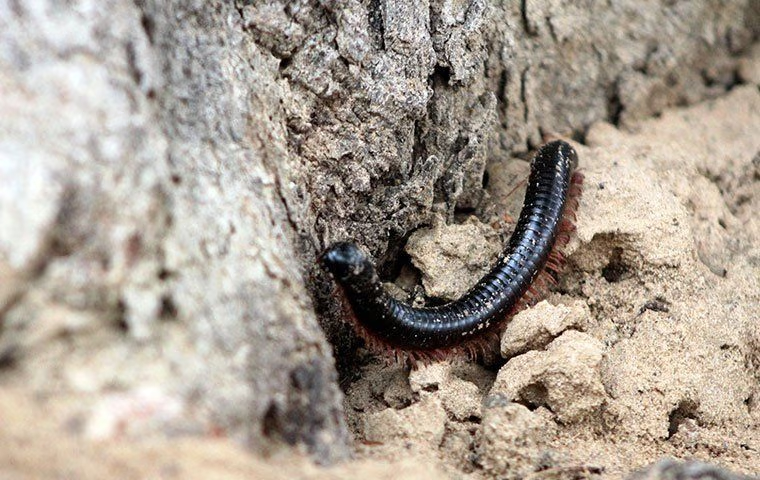Carpenter ants are notorious because of their large size and the fact that they can cause structural damage. In the United States, 24 species are considered structural or nuisance carpenter ants.
What Do Carpenter Ants Look Like?
Carpenter ants are polymorphic and measure from 1/4″ to 3/4 “long. The most common species in Florida are the Camponotus floridanus (Buckley) and the Camponotus tortuganus (Emery). Both are bicolored (black and red) and are practically a nuisance pest since they do not cause damage to sound wood like the black carpenter ant (Camponotus pennsylvannicus) common in New England and the Mid-Atlantic States. Florida carpenter ants seek existing voids to nest or excavate wood soften by moisture or fungi.
Where Do Carpenter Ants Live?
Carpenter ants usually begin a colony by excavating wood decayed or damaged by other insects. Outdoors, these ants will nest in voids of tree stumps, rotten logs, crotches between limbs, under bark, in roots of trees, under bark, fence posts, and old wooden decks.
Mature colonies of carpenter ants contain a parent nest and satellite nests nearby. Each colony has one queen and one parent nest (also known as the primary nest). The purpose of the satellite nests is to grow the territory, have access to more resources, and find drier places, which helps in the development of the larvae and pupae. It takes three to six years for a colony to mature. A mature colony produces winged reproductive and have over 3,000 individuals.
How Can I Tell The Difference Between Termites And Carpenter Ants?
Carpenter ants and termites have two things in common. They are both social insects, and both attack wood. Other than that, they are completely different bugs. Carpenter ants belong to the order Hymenoptera and termites to the order Isoptera.
Here are a few anatomical differences between the two:
- Antennae
Termites: straight and beaded antennae
Carpenter Ants: elbowed antennae
- Wings
Termites: front and back wings are the same size and twice the body length
Carpenter Ants: fore wings are larger than hind wings, and the fore wings are the same length as the body
- Waist
Termites: waist is broad and thick
Carpenter Ants: waist is constricted and slender.
Do Carpenter Ants Damage Wood?
Yes, carpenter ants will hack away wood to make room for the nest. However, carpenter ants prefer to nest in wood damaged by wood rot, decay, and mold. They can also use and expand old termite galleries.
The galleries follow the wood’s soft grain and have a smooth, clean, almost sandpapered appearance. Carpenter ants push out the chewed-up wood from the tunnel through small openings, also called windows. A pile of sawdust shavings and fragments of insect body parts often appear next to these openings. On the other hand, termites expel little pellets, which is the excrement after digesting the wood.
Because carpenter ants are attracted to damaged wood, it is imperative to correct any moisture problem around the home to prevent wood rot and decay.
What Do Carpenter Ants Eat?
Unlike termites, carpenter ants do not eat wood for nutritional purposes. They cut away wood to expand the gallery.
Carpenter ants are omnivorous, meaning they feed on animal and plant foods. Their diet consists of honeydew, plant nectar, fruit juices, and other insects (living or dead). Foragers will travel up to 300 feet from the nest to forage for food.
How Did I Get Carpenter Ants?
The nests found indoors are often satellite nests. A parent nest found indoors is most likely due to a water leak or other high moisture source. Carpenter ants move into homes looking for food. When they decide to nest indoors, they will use cavities in wall voids, windowsills, fireplaces, attic rafters, roof overhangs, fascia boards, hollow doors, under insulation, under cabinets, and bath traps.
The Difficulty Of Carpenter Ant Treatments
Carpenter ants have a reputation for being one of the most challenging pests to eliminate for several reasons:
- The foragers will often scatter, and pheromone trails are hard to notice for this species. Since they don’t form heavy pathways like other ants, you have fewer workers picking up the active ingredients and bringing them to the nest
- The carpenter ant diet is broad, and they usually go for one type of food depending on their nutritional need at that time. Therefore, choosing the right kind of bait may be difficult.
- Foraging ants travel a great distance to search for food. The parent nest location may be beyond the property line.
- Carpenter ants establish satellite nests in several locations. Treating the parent nest will prevent the ants from returning.
- Workers are primarily nocturnal. Most activity is from dusk till dawn. Sometimes a night inspection is necessary to locate the primary nest.
Treatments for carpenter ants are usually considered a specialty service. A home infested with carpenter nests may require a few trips to eliminate completely.
How To Look For Carpenter Ants?
Carpenter ants foragers usually come out at night, so the best time to find them is during the dark hours. If you suspect you have carpenter ants, walk around the property with a flashlight and look for any trailing activity that may lead to the parent nest.
This information will also help the pest management professional to target the problematic areas and expedite the elimination process. The accumulation of sawdust in certain areas of the home is another sign of carpenter ants.
Of all household-infesting ant species, carpenter ants are unique because they require specialized knowledge and training to locate the parent and satellite nests. If you intend to kill carpenter ants on your own, you will need to do some serious detective work.
How To Get Rid Of Carpenter Ants?
For the outdoor areas, treat the foundation with a non-repellent insecticide. Some products allow liquid applications around the trunk of trees, fence posts, and utility poles, which is great because they are potential nesting grounds—dispersing granular baits labeled explicitly for carpenter ants around the property.
If a satellite colony is indoors and actively trailing in and out of the home, the exterior treatment should eliminate the nest indoors. Should the problem persist after the foundation treatment, and the ants are not leaving the structure and are meeting all their nutritional needs within the house, relocating the nest and treating it is a must.
Most of the time, satellite nests are inside the wall voids. Using a listening device such as a statoscope can assist in narrowing down the location of the nest. Tapping on the wall will disturb the winged ants, and you can detect a rustling sound. Once located, treat the void with a non-repellent foam or with specialty dust. Access the wall void by removing electrical wall plates or by drilling small holes in the wall.
Why Should I Call An Exterminator For Carpenter Ants?
When confronting a full-blown carpenter ant infestation, you should hire the best exterminator in town, as this is not something Terro bait can resolve and prevent them from returning.
The moment you find one carpenter ant you should take immediate action. If you see one, a nest has to be nearby. Luckily, the carpenter ants in Florida do not attack sound wood, but any structural wood soften by moisture is game. Call a pest management professional if you suspect you have a carpenter ant infestation.
The professionals at GOTBUGSIKILL have the best training to handle any carpenter ant infestation. After eliminating the ants, we encourage our customers to sign up for recurring services. KILL365 is our pest prevention program that protects your home and keeps your family safe from several pests, including carpenter ants.
We are the best pest control company in Palm Beach, Broward, and Miami-Dade. Call now for a free estimate and get started on our effective ant control services!

